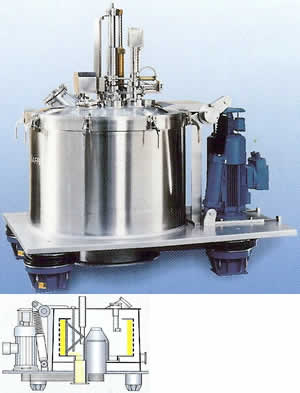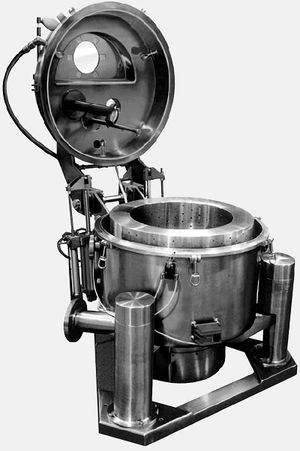Difference between revisions of "Filter Centrifuges"
(Created page with "Category:Filtration{{Knoppen}} <noinclude><!------------------------------------------------ * READ THIS FIRST * Only edit this page if you can improve the content. * Improp...") |
|||
| (5 intermediate revisions by 2 users not shown) | |||
| Line 1: | Line 1: | ||
[[Category:Filtration]]{{Knoppen}} | [[Category:Filtration]]{{Knoppen}} | ||
[[File:Filter_Centrifuges_01.jpg|thumb|right|Filter Centrifuge]] | |||
[[File:Filter_Centrifuges_02.jpg|thumb|right|Filter Centrifuge]] | |||
'''Filter Centrifuges''' separate liquids from solids by means of centrifugal forces. | |||
==Process Cycle== | |||
A typical process cycle for a batch filtering centrifuge comprises the following 7 steps : | |||
# '''Accelerate to feed speed''': The basket is accelerated to a speed suitable for feeding. | |||
# '''Feeding''': The feed solid - liquid suspension is added to the basket via feed pipe. | |||
# '''Accelerate to spin speed''': Accelerate the basket to a high rpm to produce a high ‘G’ to drive the filtration process. | |||
# '''Washing''': If required the filter cake is washed via wash pipe. | |||
# '''Drying''': Continue spinning at high ‘G’ to dry the filter cake. The filtrate leaves via outlet. | |||
# '''Deceleration''': Slow the basket to a speed suitable for cake discharge. | |||
# '''Discharge''': Discharge the cake through the bottom of the basket using the plough mechanism. | |||
==Physical limitations of filtering centrifuges== | |||
When discussing scale-up it is worth mentioning the main factors which limit the size of filtering centrifuges. At the small end of the scale these are practical considerations such as physical access to the basket and the economic cost per unit of throughput. For centrifuges with automatic feeding, washing and cake discharge there is a minimum basket diameter below which there is insufficient room to fit the services and mechanisms required. Typically this basket diameter is around 800mm, which with a maximum allowable cake depth of perhaps 100mm gives an opening in the top of the basket of 600mm. Smaller manual or semi automatic centrifuges are available although these are not common in modern process plants. | |||
==Video== | |||
<youtube>GAunSYsMeUo</youtube> | |||
Latest revision as of 02:02, 27 November 2012
Filter Centrifuges separate liquids from solids by means of centrifugal forces.
Process Cycle
A typical process cycle for a batch filtering centrifuge comprises the following 7 steps :
- Accelerate to feed speed: The basket is accelerated to a speed suitable for feeding.
- Feeding: The feed solid - liquid suspension is added to the basket via feed pipe.
- Accelerate to spin speed: Accelerate the basket to a high rpm to produce a high ‘G’ to drive the filtration process.
- Washing: If required the filter cake is washed via wash pipe.
- Drying: Continue spinning at high ‘G’ to dry the filter cake. The filtrate leaves via outlet.
- Deceleration: Slow the basket to a speed suitable for cake discharge.
- Discharge: Discharge the cake through the bottom of the basket using the plough mechanism.
Physical limitations of filtering centrifuges
When discussing scale-up it is worth mentioning the main factors which limit the size of filtering centrifuges. At the small end of the scale these are practical considerations such as physical access to the basket and the economic cost per unit of throughput. For centrifuges with automatic feeding, washing and cake discharge there is a minimum basket diameter below which there is insufficient room to fit the services and mechanisms required. Typically this basket diameter is around 800mm, which with a maximum allowable cake depth of perhaps 100mm gives an opening in the top of the basket of 600mm. Smaller manual or semi automatic centrifuges are available although these are not common in modern process plants.
Video

